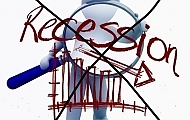By using our website, you agree to the use of cookies as described in our Cookie Policy
Blog
The Fed’s Inflation Target
Core inflation, at over 6%, is still too high, and there’s general agreement among economists that the Fed is correct in raising interest rates as it seeks to bring inflation down by cooling the economy. If the Fed starts to have success on the inflation front, then a new debate may reignite, as to whether the Fed’s 2% inflation target is appropriate or whether it should be adjusted higher.
Economist Olivier Blanchard recently made the case for a 3% inflation target rate. The clear benefit from a higher inflation target is that nominal interest rates would be higher, and consequently the Fed would have more room to lower rates if it felt that stimulative policy was needed. In fact, Blanchard, along with Giovanni Dell’Ariccia and Paolo Mauro, advocated in 2010 for a 4% inflation target. Central banks rejected this view, concerned that they risked losing credibility as inflation fighters, and believing that they would still have sufficient room to lower interest rates when needed without hitting the zero lower bound.
As Blanchard notes, that optimism was misplaced, as between 2010 and 2022 the US federal funds rate has been at the zero lower bound more often than not. Rates in the euro area and Japan have been near zero for almost the entirety of the past 12 years. While banks can use quantitative easing or experiment with negative interest rates, it may be simpler and more effective to just raise the inflation target slightly, thereby giving greater scope to reduce interest rates and less chance of bumping into the zero lower bound.
While rejecting a 2% inflation target, Blanchard has come to believe, in part based on a paper that analyzed the relationship between Google searches for “inflation” and the inflation rate itself, that inflation may take on greater salience for consumers when it rises above 3-4 percent, which would then pose the risk that inflation expectations shift upward and higher inflation becomes embedded in the economy. Consequently, Blanchard suggests that a modest shift to a 3% inflation target could allow greater room for monetary policy without setting off alarm bells for consumers.
Blanchard notes that if central banks are successful in bringing inflation down to 3%, there may ensue a lively debate as to whether it’s worth maintaining the brakes on the economy in order to squeeze out that last 1% reduction. He suspects that while central banks may not officially shift their inflation target, they may be willing to tolerate slightly elevated inflation for some time.
###
JMS Capital Group Wealth Services LLC
417 Thorn Street, Suite 300 | Sewickley, PA | 15143 | 412‐415‐1177 | jmscapitalgroup.com
An SEC‐registered investment advisor.
This material is not intended as an offer or solicitation for the purchase or sale of any financial instrument or investment strategy. This material has been prepared for informational purposes only, and is not intended to be or interpreted as a recommendation. Any forecasts contained herein are for illustrative purposes only and are not to be relied upon as advice.
‹ Back











